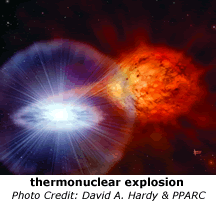X-ray bursts are among the most fascinating of astrophysical phenomena. Now, a new finding by a team led by University of Notre Dame astrophysicist Michael Wiescher will enable researchers to derive many more qualitative predictions about X-ray burst behavior and characteristics.
X-ray bursts are thermonuclear explosions in the outer atmosphere of accreting neutron stars. The accreted hydrogen and helium-rich material burns through steady fusion processes, heating the neutron star atmosphere toward the ignition point.
The thermonuclear explosion is triggered by a specific nuclear fusion process between the radioactive oxygen isotope 15O and accreted helium 4He. This fusion process is the gateway to rapid conversion of the initial carbon and oxygen material to heavier elements in the nickel to cadmium range.
X-ray bursts are now frequently observed with modern space telescopes and show a recurrence frequency ranging from hours to days. Changes in accretion conditions lead to interruption of the recurrent burst pattern. The specific reaction rate for the 15O+4He fusion determines the exact ignition conditions and provides experiment-based limits for the accretion rate.
Twenty years ago, astrophysicists predicted that the reaction rate of 15O+4He was dominated by a single resonance. Numerous research groups have tried to measure the resonance and its strength to help determine the trigger temperature for X-ray bursts.
A direct measurement of the resonance would require high intensity radioactive oxygen beams, which have not yet been achieved at current radioactive beam facilities. Indirect studies require highly sensitive measurements of what researchers term “the alpha-decay” branch of the resonance level.
“Despite considerable effort over the years, our present knowledge has been limited to an estimate of the upper limits of the strength,” Wiescher said.
Wiescher and his team have performed the first successful measurement of the alpha-decay branch of the resonance level using the Notre Dame TwinSol system in the University’s Nuclear Structure Laboratory. Based on this result, and coupled with the first successful lifetime measurement of the resonance level at Notre Dame, the reaction rate of the thermonuclear explosion of X-ray bursts has been determined with much improved accuracy.
“This result allows us to derive many quantitative predictions about the X-ray burst pattern behavior and characteristics,” Wiescher said. “Most importantly, it allows us to determine the ignition point of the thermonuclear runway. It also provides for the first time stringent experimental limitations for the neutron star accretion rate leading to the observed recurrent type-I burst patterns.”
“This is an excellent example for nuclear laboratory data providing stringent limits for the model interpretation of astrophysical observations,” Wiescher said. “In this case, the identification of the boundary conditions for stellar thermonuclear explosion at the extreme environmental condition prevailing on the surface of a neutron star.”
Source: University of Notre Dame
























